Hello, bird enthusiasts!
Welcome to an informative article on the fascinating avian residents of Oklahoma.
In this piece, we will explore the diverse bird species that grace the skies and landscapes of this beautiful state.
From majestic raptors to cheerful songbirds, Oklahoma is home to a rich variety of feathered friends.
Join me as we embark on a journey to discover 16 common birds that call Oklahoma their home.
Let’s spread our wings and delve into the enchanting world of these avian wonders!
| Image | Bird | Features | Price |
|---|---|---|---|
 |
| 9.7 | Check Price |
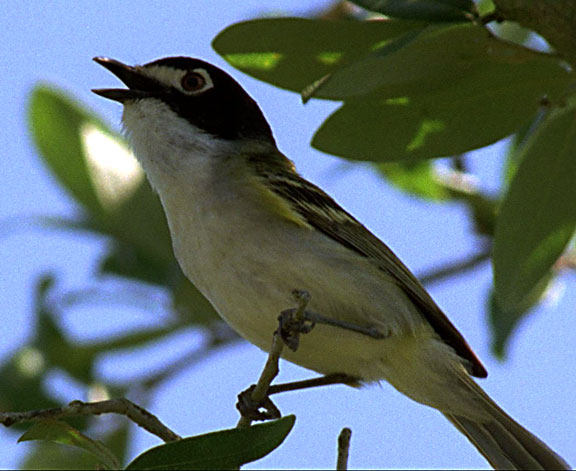 |
| 9.5 | Check Price |
 |
| 9.1 | Check Price |
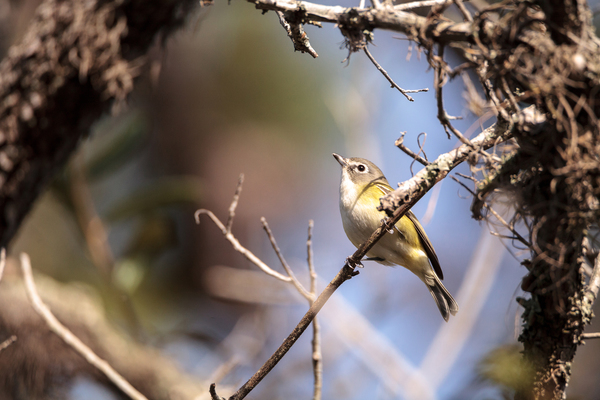 |
| 8.8 | Check Price |
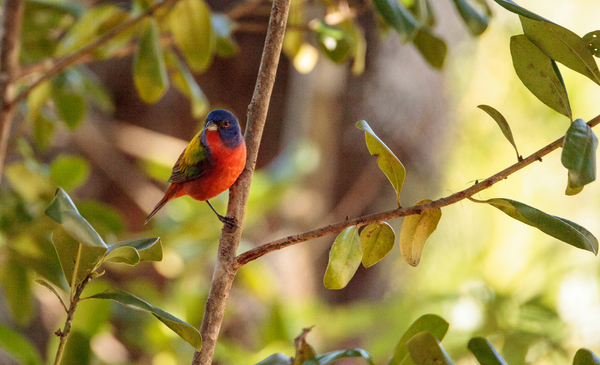 |
| 8.6 | Check Price |
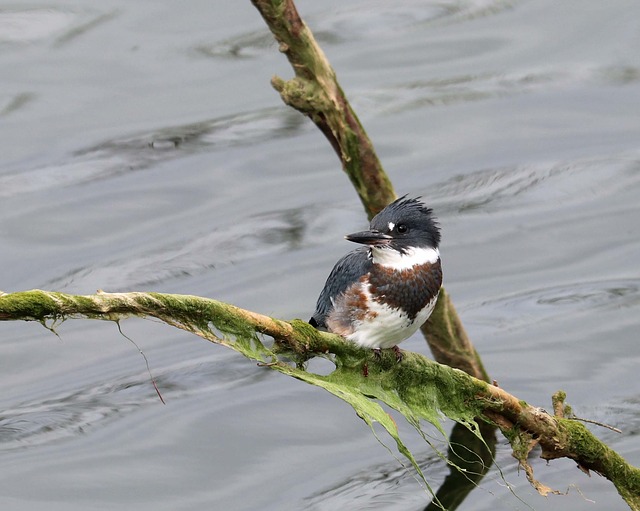 |
| 8.2 | Check Price |
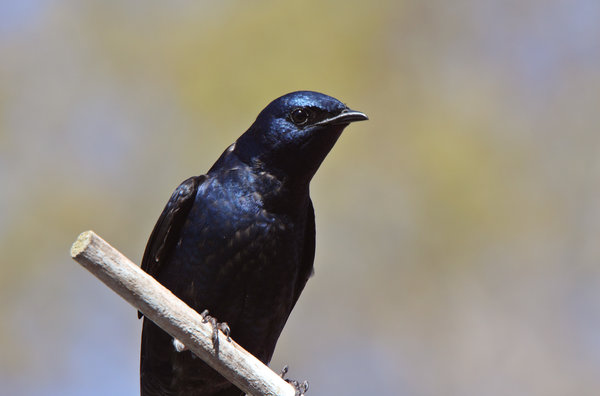 |
| 8 | Check Price |
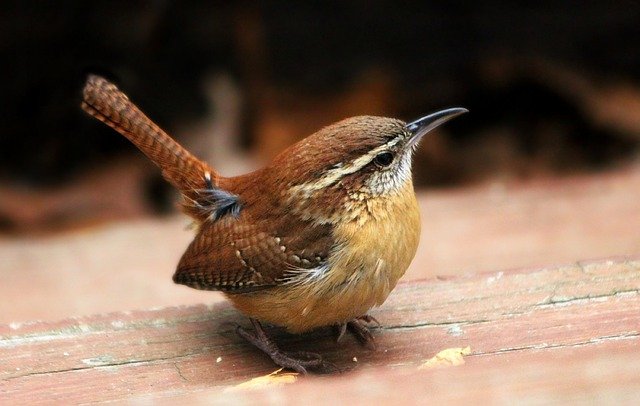 |
| 7.7 | Check Price |
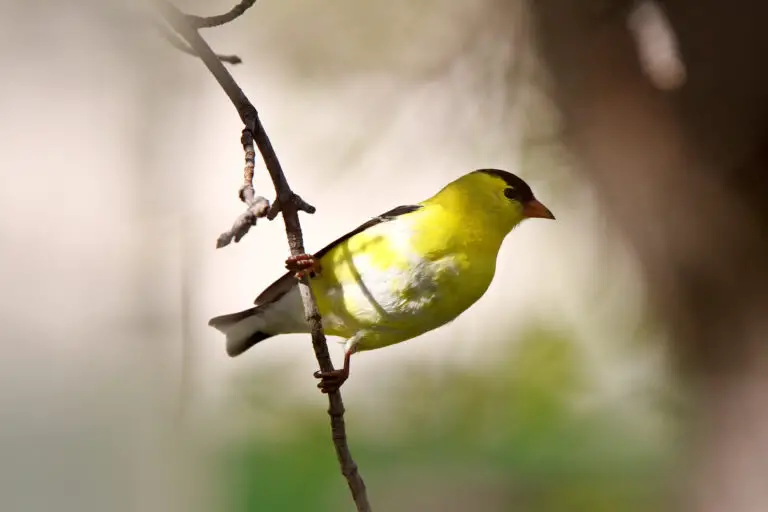 |
| 7.4 | Check Price |
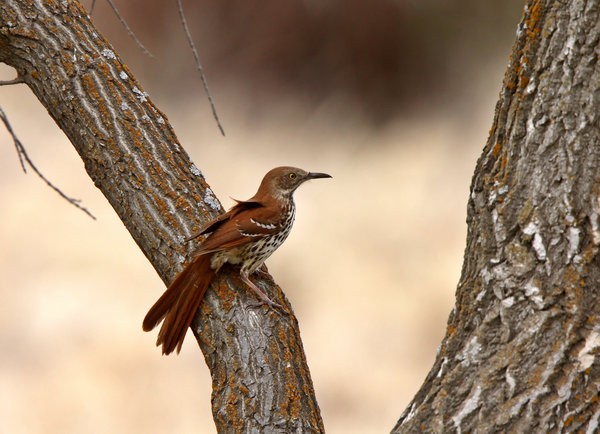 |
| 7.2 | Check Price |
 |
| 9.5 | Check Price |
 |
| 9.5 | Check Price |
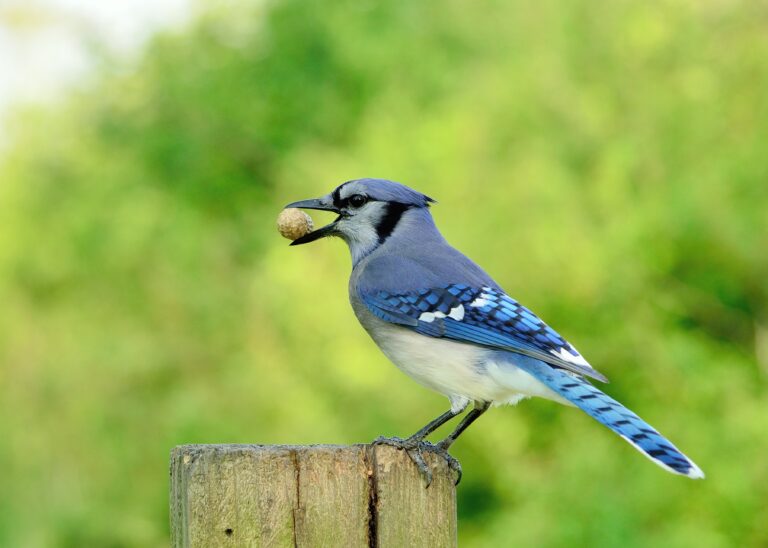 |
| 9.5 | Check Price |
 |
| 9.5 | Check Price |
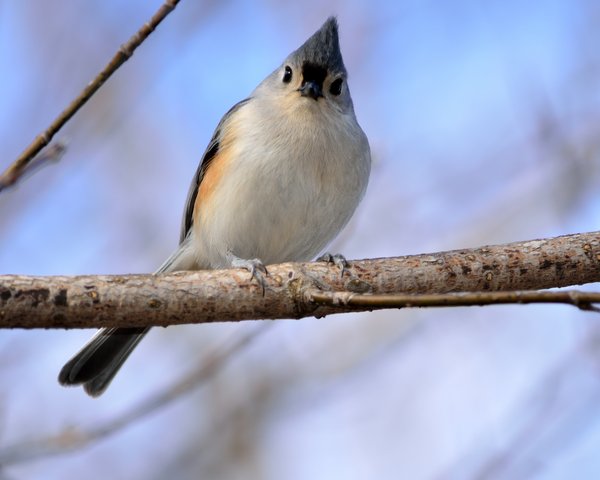 |
| 9.5 | Check Price |
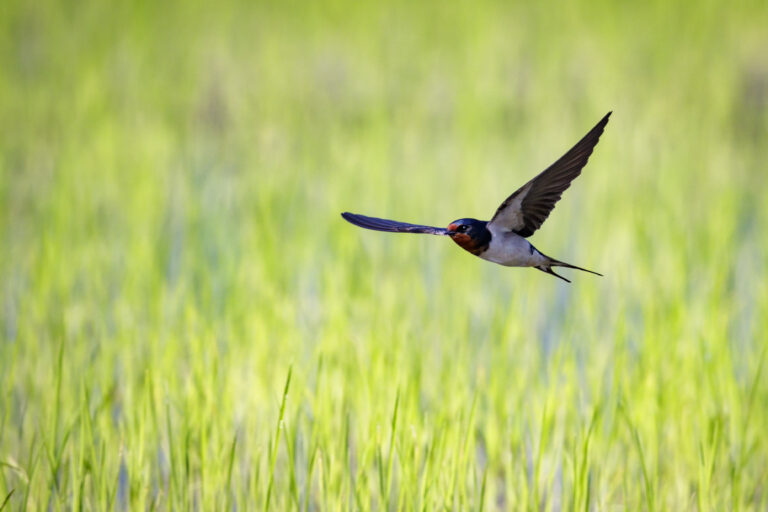 |
| 9.5 | Check Price |
Oklahoma has approximately 480 bird species, so your chances of seeing a new bird are quite excellent.
If you don’t have the time to read the whole article, check out this video on 16 Common Birds in Oklahoma for a quick understanding.
Common Birds in Oklahoma
1. Brewer’s Blackbird

This bird is smaller than a robin and has a long, pointed, black beak.
Brewer’s blackbirds are occasionally mistaken with other species but may be differentiated due to some characteristic features such as the long rudder-like tail of the common grackle or the conical beak and the shorter tail of the brown-headed cowbird.
Brewer’s blackbirds are commonly seen in pastures, feedlots, cultivated fields, and riparian forests.
During the winter, these birds can be seen virtually statewide, although they are considerably more abundant in central and western Oklahoma.
When they are not at the feeders, they consume insects, seeds, and occasional fruit.
The length ranges from 8.3 to 9.8 inches.
The wingspan is 14.6 inches.
Brewer’s blackbirds congregate with other blackbirds to feed.
They would rather eat on the ground.
Below are the characteristics of the Brewer’s Blackbird,
| Scientific Name | Euphagus cyanocephalus |
| Family Name | Icteridae |
| Length | 9-11 inches |
| Weight | 2.5-3.5 oz |
| Wingspan | 14-15 inches |
| Habitat | Open fields, urban areas |
| Food | Insects, seeds, berries, fruits, nectar |
2. Black-capped Vireo

The back, wings, and sides of the black-capped Vireo are greenish.
The breasts and stomach are white.
For breeding and feeding, black-capped vireos prefer low, brushy, dispersed thickets of deciduous trees, particularly blackjack oak.
Such an environment is largely located in the state’s southwest quadrant and has historically been preserved by periodic fire and drought.
In Oklahoma, there are currently just two known populations of black-capped vireos.
The biggest is found in Comanche and Kiowa counties in the Wichita Mountains.
This species used to be found in numerous, scattered congregations throughout the Cross Timbers Ecoregion in the west to middle Oklahoma.
These migratory species spend the springtime, midsummer, and winter in Oklahoma or Houston.
Vireos often come to Oklahoma in the semi and depart in mid-September.
The eggs are laid in a little hanging nest that is built at the end of a branch 4-8 feet from the level on a short, scrubby tree.
Below are the characteristics of the Black-capped Vireo,
| Scientific Name | Vireo atricapilla |
| Family Name | Vireonidae |
| Length | 4.5-5 inches |
| Weight | 0.3-0.4 oz |
| Wingspan | 7-9 inches |
| Habitat | Oak woodlands, shrublands |
| Food | Insects, spiders, caterpillars |
3. Brown-headed Cowbird

A moderate North American bird, the Molothrus water is also referred to as the Brown-headed Cowbird.
The Brown-headed Cowbird is a migrating bird that follows climate trends and looks for nourishment.
The bird has the form of a conventional crow, but its back is brighter.
They regularly visit the north throughout the summer.
Excluding the brown throat & head, which are brown rather than black, the Brown-headed Cowbird possesses all feathers.
This bird’s black coloration is more bluish-black than it is pure black.
Males have brighter and shinier plumage than females.
Brown or black plumage covers the female. Females are relatively small as males, get a smaller span, and weigh a lot less.
Due to their different appearance, females within the flock are clearly differentiated from males.
The bird sings a high-pitched melody to lure females to breeding.
They are migrant birds, meaning they move from one region to another.
Below are the characteristics of the Brown-headed Cowbird,
| Scientific Name | Molothrus ater |
| Family Name | Icteridae |
| Length | 7-8.5 inches |
| Weight | 1.5-2.3 oz |
| Wingspan | 12-15 inches |
| Habitat | Open woodlands, pastures, fields |
| Food | Seeds, insects, spiders, berries |
4. White-eyed Vireo

Among the smallest birds in Oklahoma is the White-eyed Vireo, which is alternatively called Vireo griseus.
The White-eyed Vireo is a seasonal bird that travels from north to central and southern America.
The feather coat of the White-eyed Vireo is striking and vivid.
This bird’s crown and neck are covered with olive-colored plumage.
The tops, backs, and wings of the bird appear olive to dark, having black and white margins.
A whitish ring can be seen in its eyes.
Their belly is yellow in color.
The overall length of a White-eyed Vireo may vary between 4.3 and 5.1 inches (11 to 13 centimeters), with a wingspan of about 6.7 inches (17 centimeters).
The mother White-eyed Vireo lays 3 to 6 eggs.
The eggs are sat on by both the male as well as female before they hatch.
They construct cup-shaped exposed nests.
They also eat tiny grains, nuts, and fruits from a variety of plants.
Below are the characteristics of the White-eyed Vireo,
| Scientific Name | Vireo griseus |
| Family Name | Vireonidae |
| Length | 4.5-5 inches |
| Weight | 0.4-0.5 oz |
| Wingspan | 7-9 inches |
| Habitat | Brushy areas, thickets, shrublands |
| Food | Insects, spiders, berries, fruits |
5. Painted Bunting

The backs and wings of Painted Buntings are yellow-green, with dark grey highlighting on the wings and black wingtips.
It has a long grey tail and a reddish-orange lower back, with a vivid orange-red breast and abdomen.
The red hue extends all the way to the bill, with blue flanking lines at the shoulder.
This bird has a short, curved grey beak and a prominent eyeing, which is typically red.
Females and adolescents will have no marks other than a little eyering and will also be yellow-green all over.
These tiny lovelies are 4.7 – 5.1 inches long, with wingspans ranging from 8 to 8.5 inches.
Fields are also common haunts for them, as long as they are overgrown enough to give some cover.
Black Oil and White Proso Millet Sunflower seeds will make Painted Buntings extremely happy, but we recommend that you use a protective cage over the feeding tube to keep larger birds away.
Because they are shy birds, they require particular protection.
Below are the characteristics of the Painted Bunting,
| Scientific Name | Passerina ciris |
| Family Name | Cardinalidae |
| Length | 4.7-5.5 inches |
| Weight | 0.5-0.8 oz |
| Wingspan | 7.5-9 inches |
| Habitat | Brushy areas, woodlands, thickets |
| Food | Seeds, insects, berries, fruits |
6. Belted Kingfisher

The Belted Kingfisher, a moderate-sized kingfisher, having a stripe across its neck, is a part of the kingfisher family.
Their beaks are huge and strong, and they have a bushy crest on their heads.
Males of these birds are brighter and possess more striking colors compared to females.
Its blue and black wings typically contain white spots.
The male Belted Kingfisher is 27 to 34 centimeters in length and has 47 to 57 centimeters of wingspan.
The weight of a fully-grown Belted Kingfisher ranges from 113 to 178 grams.
Due to reverse dimorphism, females are bigger compared to males, having a wider wingspan as well as more weight.
Among numerous creatures, they consume tiny amphibians, rats, and lizards.
The females deliver eggs and then wait for them to hatch.
The male, as well as the mother, give food to their offspring.
Below are the characteristics of the Belted Kingfisher,
| Scientific Name | Megaceryle alcyon |
| Family Name | Alcedinidae |
| Length | 11-13 inches |
| Weight | 4.9-6.8 oz |
| Wingspan | 19-23 inches |
| Habitat | Rivers, lakes, streams, coastlines |
| Food | Fish, crustaceans, insects, small amphibians |
7. Purple Martin

Purple Martin’s name comes from its feather coat, which is not actually purple but instead blackish-blue, but takes on a sparkling purple color as they soar in the light.
Greenish-blue colors can also be seen in their beautiful feathers.
Female Purple Martins differ from male Purple Martins since they are smaller and lighter than male Purple Martins.
They have brown chests and undersides, as well as a brown stomach.
Moving closer to the edges of its body, the above parts turn purple and fade to white.
The overall length of a fully grown bird can be anywhere between 7.5 to 7.9 inches, while the wingspan can be anywhere between 15.3 to 16.1 inches.
Purple Martins can weigh anywhere from 1.6 to 2.1 oz as adults.
They return to the North with the arrival of the cold season.
Bugs and small insects are eaten by this bird.
They attack their target from above.
They usually stop by bird feeders all across North America.
Below are the characteristics of the Purple Martin,
| Scientific Name | Progne subis |
| Family Name | Hirundinidae |
| Length | 7-8.5 inches |
| Weight | 1.6-2.1 oz |
| Wingspan | 15-16 inches |
| Habitat | Open areas, near water |
| Food | Insects, aerial prey, flying insects |
8. Carolina Wren

The Carolina Wren is distinguished by its cinnamon-colored back, wings, and tail.
Look for little black and white ‘cubes’ on this bird’s wings and tail, as well as its yellow-orange breast and underbelly.
This bird has brown coloring on the upper section of its face, while the throat and bottom portion of its face are white.
There’s also a speck of black-dotted grey under the eye that extends to the cheek.
This bird has a lengthy, slightly curved black beak and a prominent white forehead mark visible above the eye.
The length of these little birds ranges from 4.7 to 5.5 inches, with wingspans of roughly 11.4 inches.
While you may hear them sing from the tops of trees, you’re more likely to hear them from thickets, where they may forage in relative safety.
These birds mostly eat insects, although they also consume seeds and berries.
Add some chopped cherries or strawberries and leave out the White millet mixed with Black Sunflower seeds for the best results.
If you have some shrubs in your yard, this is a bonus for bringing the Carolina Wren.
Below are the characteristics of the Carolina Wren,
| Scientific Name | Thryothorus ludovicianus |
| Family Name | Troglodytidae |
| Length | 5-6 inches |
| Weight | 0.6-0.8 oz |
| Wingspan | 11-12 inches |
| Habitat | Woodlands, thickets, gardens |
| Food | Insects, spiders, small invertebrates |
9. American Goldfinch
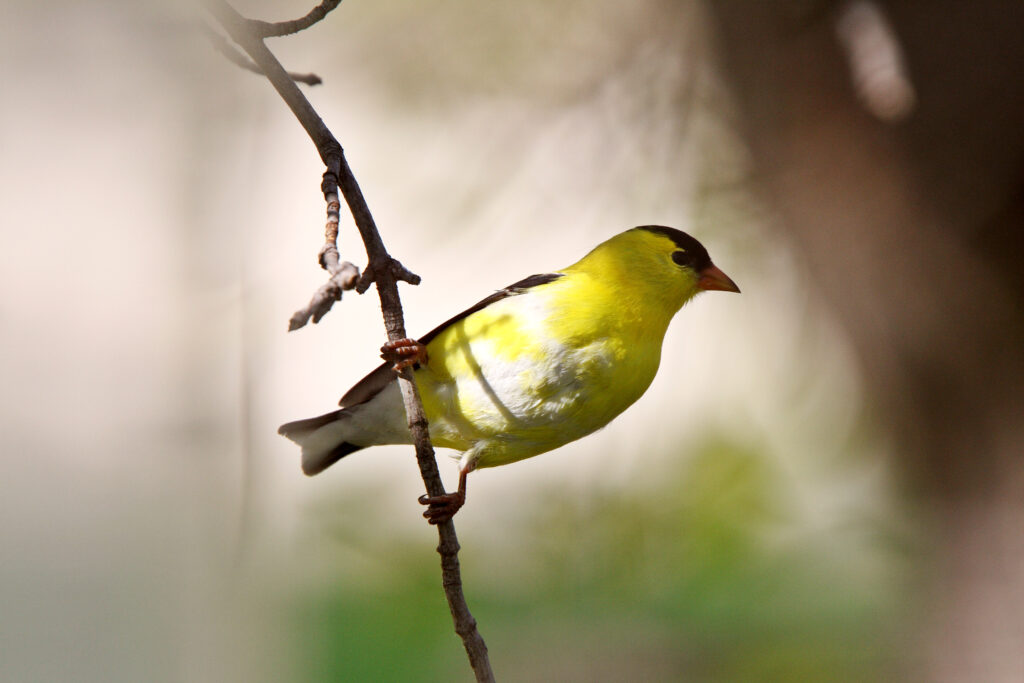
They have long, black tails with white patterns, and their breast and underside contrast with their brilliant yellow hue.
This bird has a white rump and yellow cheeks, as well as a black cap that runs from the top-middle of the head right down to the short, conical orange beak.
Females have dimmer yellows and olive coloring instead of black, and both sexes molt their colorful plumage in the winter in favor of drab brown feathers.
The unique wing bar is still evident, although dimly, so they are still simple to spot if you look closely.
These little birds range in length from 4.3 to 5.1 inches and have wingspans ranging from 7.5 to 8.7 inches.
This bird prefers to graze in flood-prone areas and large, open weedy fields.
Oil of Saffron Sunflower seeds combined with Nyjer seed will attract and maintain an American Finch’s interest.
Below are the characteristics of the American Goldfinch,
| Scientific Name | Spinus tristis |
| Family Name | Fringillidae |
| Length | 4.3-5 inches |
| Weight | 0.4-0.7 oz |
| Wingspan | 7.5-9.8 inches |
| Habitat | Fields, meadows, gardens |
| Food | Seeds, primarily thistle seeds |
10. Brown Thrasher

Toxostoma rufum, which is alternatively called Brown Thrasher, is a big bird belonging to the Mimidae family.
Small birds possess a genealogical connection with these birds.
Brown Thrashers may be found in rocky areas all throughout the globe, especially in the United States.
The bird is completely coated in brown color, just like its name suggests.
It has deep brown or black markings on the tips of its feathers and above its wings.
Because its structure, color, and length are so identical, it’s tough to distinguish male and female Brown Thrasher birds.
Brown Thrasher youngsters are born lacking feathers and in a dull color scheme.
Brown Thrashers possess a wingspan of 29 to 33 centimeters and a body length of 23.5 to 30.5 centimeters.
A typical fully-grown Brown Thrasher weighs between 61 and 89 grams (2.2 to 3.1 oz).
The female bird delivers three to five eggs, and she monitors them until they hatch.
Throughout this period, the male feeds the entire family.
Tiny insects and larvae are the main foods of the Brown Thrasher.
Various plants’ nuts, grains, berries, or buds are eaten by the Brown Thrasher.
If you put suet and other such things in the bird feeders, they will come on a fairly frequent basis.
Below are the characteristics of the Brown Thrasher,
| Scientific Name | Toxostoma rufum |
| Family Name | Mimidae |
| Length | 9-11.5 inches |
| Weight | 2.5-3.1 oz |
| Wingspan | 11.5-12.5 inches |
| Habitat | Woodlands, thickets, scrubby areas |
| Food | Insects, fruits, berries, seeds, small reptiles and amphibians |
11. Red-headed Woodpecker
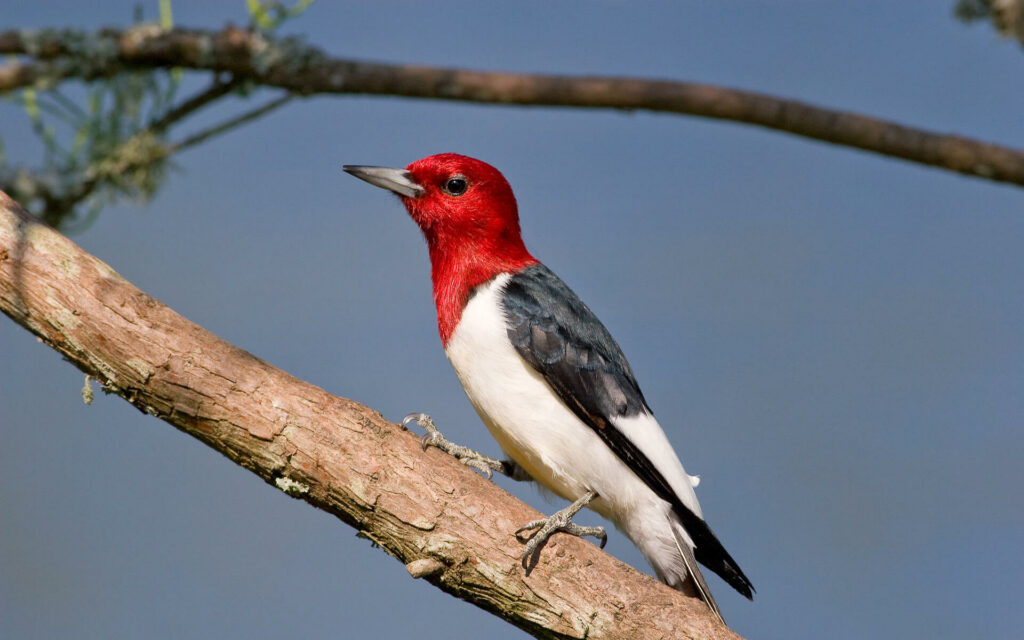
The Red-headed Woodpecker is a small woodpecker bird endemic to North America.
This bird is a migrating bird that relocates from northern regions to southern parts of the country throughout the winter.
Red-headed woodpecker comes out after the bird’s gleaming reddish-brown plumage.
This bird’s plumage is stunning and gleaming.
Their backs have a black & white design on them.
Their tail is also black.
They have a sharp, strong beak, which they use to peck into tree roots.
The Red-headed Woodpecker’s belly, rump, and chest are completely white.
The young Red-headed Woodpecker’s forehead is grey.
The overall length of an adolescent Red-headed Woodpecker is 19 to 25 centimeters (7.5 to 9.8 in), and the wing is up to 42.5 cm (7.5 to 9.8 in).
A fully grown Red-headed Woodpecker may reach somewhere from 57 to 98 grams (2.0 to 3.4 oz).
The Red-headed Woodpecker is well-known for digging holes in tree trunks and residing there.
Its bird eats insects caught in mid-flight as a result of this breed.
They don’t eat much from the ground.
They primarily seek food in the woods.
Tiny grains, nuts, and oats are their favorite foods.
Below are the characteristics of the Red-headed Woodpecker,
| Scientific Name | Melanerpes erythrocephalus |
| Family Name | Picidae |
| Length | 7-9 inches |
| Weight | 2.2-3.2 oz |
| Wingspan | 16-17 inches |
| Habitat | Woodlands, forests, open areas |
| Food | Insects, fruits, nuts, seeds, berries, and occasionally small vertebrates |
12. Ruby-throated Hummingbird

This bird is a tiny North American hummingbird.
As migrant humming subspecies, they travel south in the wintertime.
The upper portions of the Ruby-throated Hummingbird are iridescent green, with fair-skinned undersides.
Their beak is big, and their wings are brown or black.
Female birds of this species are very identical to the males, although their necks are not as red.
The body length of a Ruby-throated hummingbird is 7 to 9 cm (2.8 to 3.5 in), and its wing is 8 to 11 cm (3.1 to 4.3 in).
As an adult, a Ruby-throated hummingbird might range anywhere from 2 to 0.2 g (0.071 to 0.212 oz).
They’re only little birds. With their long beaks, they suck nectar from the flower’s ovary.
They eat microscopic insects and worms throughout their migration and flying.
Below are the characteristics of the Ruby-throated Hummingbird,
| Scientific Name | Archilochus colubris |
| Family Name | Trochilidae |
| Length | 3.5 inches |
| Weight | 0.1-0.2 oz |
| Wingspan | 3.1-4.3 inches |
| Habitat | Woodlands, gardens, meadows |
| Food | Nectar, small insects, spiders, tree sap |
13. Blue Jay
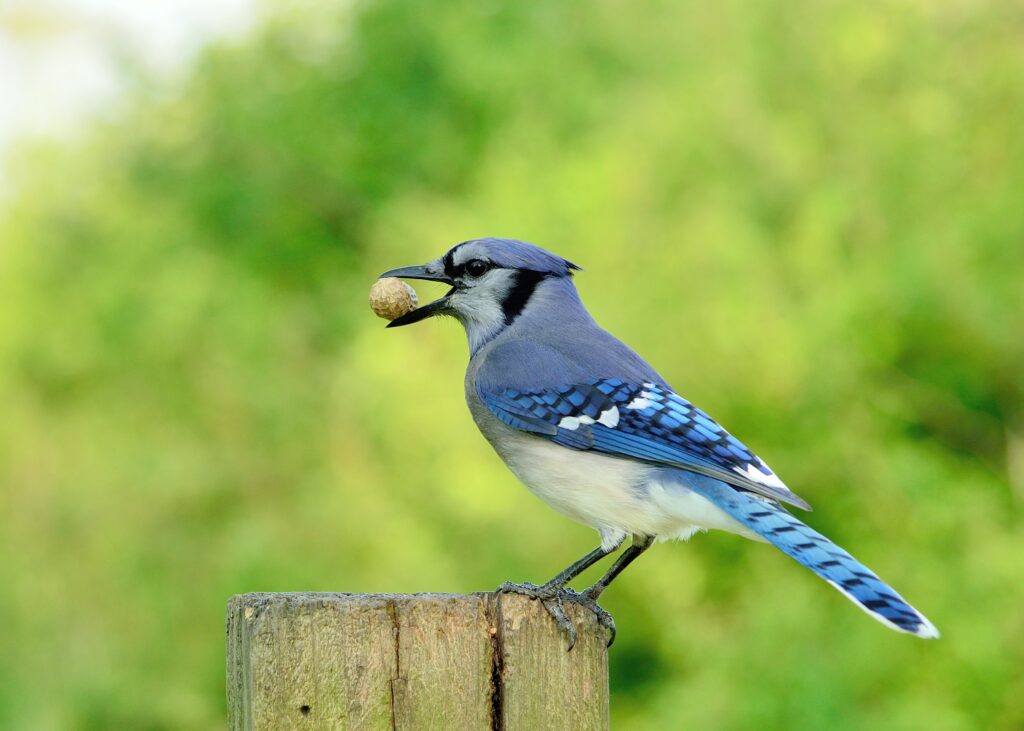
Blue Jays are beautiful and simple to identify.
They have complete blue backs with a ‘scaling’ pattern of blue highlighted in black beginning just above the white wing bar on each wing and progressing towards the tail with bigger white spots defined in black.
The underside of the tail is white and features symmetrically segmented patterns of lighter blue accentuated in black or dark blue.
This bird’s chest and underside are completely white, with quite a black stripe going from the rear of its lovely crest across the neck to the other side.
This bird has a white patch with a thin black mask that zigzags and links to the lines at the rear of the skull, creating a ‘conceptual’ look.
This bird’s beak is long and straight. These birds are 9.8 – 11.8 inches long from tip to tail, with wingspans ranging from 13.4 to 16.9 inches.
These birds prefer spending time at the forest’s edge, especially around oak trees and their tasty acorns.
Blue Jays, who are not afraid of humans, spend a lot of time in cities and would happily visit your feeder for some well-chosen treats.
Blue Jays will consume a variety of foods, but their favorites include Sunflower seeds, almonds, and suet.
Below are the characteristics of the Blue Jay,
| Scientific Name | Cyanocitta cristata |
| Family Name | Corvidae |
| Length | 9-12 inches |
| Weight | 2.5-3.5 oz |
| Wingspan | 13-17 inches |
| Habitat | Forests, woodlands, urban areas |
| Food | Seeds, nuts, insects, fruits, small vertebrates |
14. Downy Woodpecker

The Downy Woodpecker is a little bird that is a member of the woodpecker family.
The bird’s appearance is mostly black, having white spots on its wings and black and white bands on its head.
The male and female birds of this woodpecker have comparable body colors, but the female does not have the male’s red dot on the head.
The Downy Woodpecker possesses a whitish stomach and white spots on its wings.
A male Downy Woodpecker features a larger wingspan and weighs considerably more than a female.
In terms of physical size, female Downy Woodpeckers are somewhat shorter compared to their male counterparts.
Tiny insects, nuts, and berries from small plants are eaten by this tiny bird.
They are enticed by the feeders that provide them with suet.
During the wintertime, they are more likely to be found in feeding locations than during the summer.
Below are the characteristics of the Downy Woodpecker,
| Scientific Name | Dryobates pubescens |
| Family Name | Picidae |
| Length | 5.5-6.7 inches |
| Weight | 0.7-1 oz |
| Wingspan | 9.8-11.8 inches |
| Habitat | Woodlands, forests, parks, gardens |
| Food | Insects, larvae, seeds, berries, sap |
15. Tufted Titmouse

The Tufted Titmouse is a tiny North American bird species.
It has a black plume attached to its brow.
The overall length of a fully grown Tufted Titmouse is 5.6 to 6.2 inches (13 to 16 centimeters), having a wingspan of 7.9 to 10.2 inches (20-26 centimeters) and bodyweight of 20 to 26 grams.
Men and women have the same physical shape and size.
These birds may appear to be similar, but you can tell them apart by their tufted crown.
The Tufted Titmouse has a dark main body with a white belly.
They feature blemish flanks as well as a rust-colored upper chest.
On the back of its forehead, the Tufted Titmouse features a tufted grey crest/crown, which would be complemented with either a black forehead.
They have a wonderful and lovely melody with around 20 distinct rhythm variants.
They employ these many rhymes in various circumstances, resulting in a varied type of song depending on the situation.
They do not build exposed nests, unlike several other species.
Instead, they make their nests within the crevices in tree trunks.
Grain and seeds from a variety of tiny plants and herbs are their main sources of nutrition.
Tiny berries and fruits are some of this bird’s favorite food.
Bugs and wasps are among the Tufted Titmouse’s additional preferred foods.
Below are the characteristics of the Tufted Titmouse,
| Scientific Name | Baeolophus bicolor |
| Family Name | Paridae |
| Length | 5.5 inches |
| Weight | 0.6-0.8 oz |
| Wingspan | 7.9-10.2 inches |
| Habitat | Woodlands, forests, parks, gardens |
| Food | Insects, seeds, nuts, berries, small fruits |
16. Barn Swallow
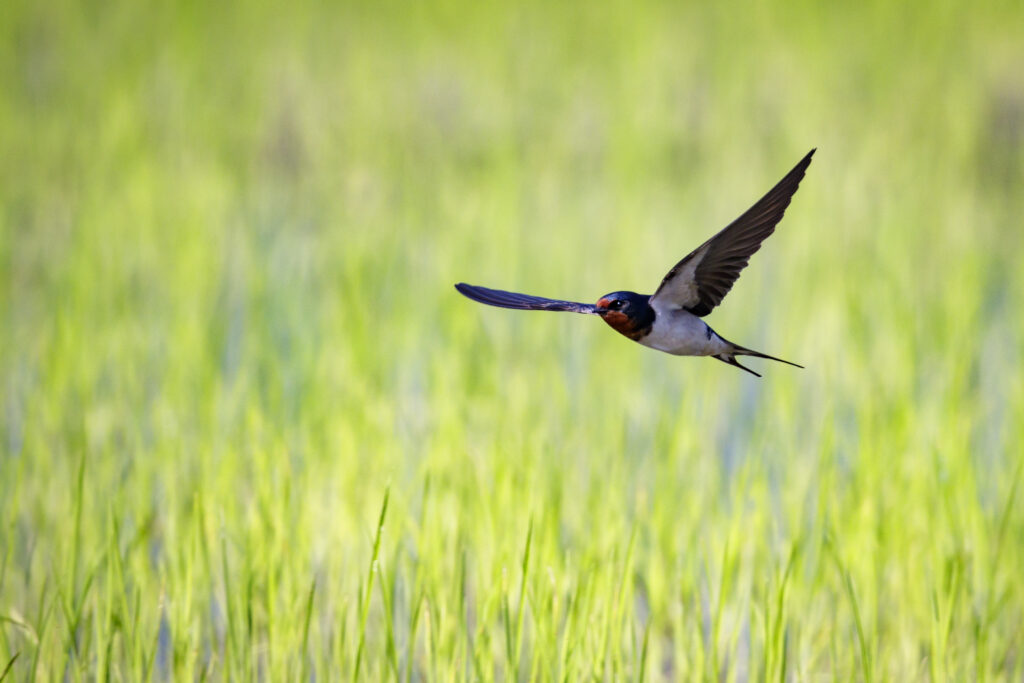
Barn Swallow is a member of the Hirundinidae family, and it is a moderate-sized bird.
These birds are also among the most commonly found swallow birds on Earth.
They are distinguished by their longer tail and beautiful blue and white feathers.
The upper portions and tails of the Barn Swallow are basically fully vividly colored.
However, the chest and stomach are totally white.
Blackish-brown rings decorate the necks in an identical style.
A Barn Swallow’s standard overall length is 7 inches, with a maximum wingspan of 33 centimeters.
The average adult guy weighs roughly 20 grams.
Females are shorter, lightweight, and have a reduced wingspan compared to their male counterparts.
These birds have longer bodies compared to other birds due to their lengthy tail.
Its body is average, but its twisted tail is longer.
The plumage color of young Barn Swallows is unusual, having black above parts and wings as well as creamy white bottoms and chests.
They consume smaller insects like large flies, small moths, as well as other tiny invertebrates and larvae.
Below are the characteristics of the Barn Swallow,
| Scientific Name | Hirundo rustica |
| Family Name | Hirundinidae |
| Length | 6.7-7.9 inches |
| Weight | 0.6-0.7 oz |
| Wingspan | 11.8-13.4 inches |
| Habitat | Open areas, fields, wetlands |
| Food | Insects, flying ants, beetles, flies, mosquitoes |
Conclusion
In conclusion, Oklahoma’s bird population offers a delightful tapestry of colors, songs, and behaviors.
Throughout this article, we have acquainted ourselves with 16 common bird species that grace the skies and landscapes of the state.
From the soaring elegance of the Belted Kingfisher to the melodic tunes of the Ruby-throated Hummingbird, each bird brings its unique charm to the vibrant ecosystem of Oklahoma.
As we observe these magnificent creatures in their natural habitats, let us appreciate the intricate beauty and importance of their presence.
Whether you are an avid birder or simply appreciate nature’s wonders, Oklahoma’s birds provide a constant source of awe and inspiration.
So, grab your binoculars, explore the great outdoors, and let the captivating world of birds in Oklahoma captivate your heart and imagination.
Happy birdwatching!
FAQ
What is the state bird of Oklahoma?
The state bird of Oklahoma is the Scissor-tailed Flycatcher. It is known for its long, distinctive tail and graceful aerial acrobatics.
Are there any endangered bird species in Oklahoma?
Yes, there are several endangered bird species in Oklahoma, including the Whooping Crane and the Interior Least Tern. Efforts are being made to protect and conserve these species and their habitats.
When is the best time to go birdwatching in Oklahoma?
The best time for birdwatching in Oklahoma is during the spring and fall migration seasons. Many species pass through the state during these times, offering excellent opportunities for sightings.
Are there any bird sanctuaries or nature reserves in Oklahoma?
Yes, Oklahoma is home to several bird sanctuaries and nature reserves. Some notable ones include the Wichita Mountains Wildlife Refuge, Red Slough Wildlife Management Area, and the Hackberry Flat Wildlife Management Area. These areas provide protected habitats for a wide variety of bird species.
How can I contribute to bird conservation efforts in Oklahoma?
You can contribute to bird conservation in Oklahoma by supporting local conservation organizations, participating in citizen science programs like bird counts, providing bird-friendly habitats in your own backyard, and spreading awareness about the importance of preserving bird populations and their habitats.
Last Updated on June 5, 2023 by Lily Aldrin
